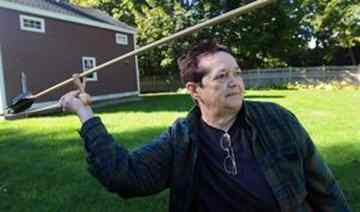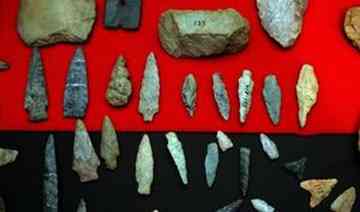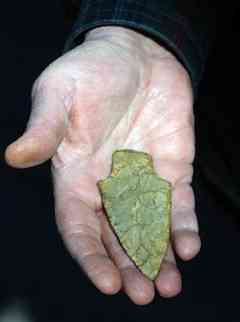Using a prehistoric weapon, Ro Martinis launched a 6-foot, lightweight spear about 20 feet across the Ashland Historical Society's lawn, the point sinking into the ground with a "thunk."
 Some 12,000 years ago, a mammoth or deer might have found itself on the receiving end of that sharp point, and ultimately, cooking over a hunter's fire. "They didn't have Stop & Shops back then," Martinis said.
Some 12,000 years ago, a mammoth or deer might have found itself on the receiving end of that sharp point, and ultimately, cooking over a hunter's fire. "They didn't have Stop & Shops back then," Martinis said.
Next Sunday, Oct. 17, aspiring Stone Age hunters can learn at the Ashland Historical Society how their ancient predecessors once managed to bring down the likes of mastodons for dinner.
Guest experts Bob Berg and Jeff Gottlieb will explain, demonstrate and lead hands-on work with the atlatl, a prehistoric spear-launching weapon that predates the bow and arrow.
They also will teach participants about other primitive arts, such as starting a fire with a hand drill or making rope from hemp, flax or milkweed.
Martinis and a friend, Rose Condon, are organizing the free event with the aid of the Historical Society's Wilma Slaight. Also on display will be Martinis and Condon's extensive collection of Stone Age tools.
The event will run from 2 to 4 p.m. at the Historical Society, 2 Myrtle St.
Condon and Martinis said they have been collecting artifacts for about 50 years. Their hobby began as youths exploring the beaches of Nantucket, and in 1960, Martinis aided Condon's cousin, Bob Carlson, in a dig for the Mass. Archeological Society in Framingham.
 Many of the artifacts on display next weekend came from that dig, Martinis said. She has been fascinated with prehistoric times since then, particularly by how people survived day to day. It helps one appreciate modern life, she said.
Many of the artifacts on display next weekend came from that dig, Martinis said. She has been fascinated with prehistoric times since then, particularly by how people survived day to day. It helps one appreciate modern life, she said.
"To me, history isn't the last couple hundred of years," Martinis said. "It's the last 1,000 years. There's so much history people don't know, because it's gone."
Martinis demonstrated the atlatl, pronounced "AT-lat-uhl" or "AT-uhl-AT-uhl." The device is a narrow piece of wood about two feet long. A lightweight spear called a dart sits on top of it, with the butt resting against a notch on the rear end of the weapon. The device has a handle in the front.
By whipping the device forward by the handle, the atlatl launches a dart faster and farther than possible by hand. "The whole idea is it's a lever action," Martinis said.
That brought an advantage for hunters, she said. Before the atlatl, they mainly used manual spears, which were heavy. "If you missed," Martinis said, "you have to go find another spear."
 But the atlatl allowed the use of lighter darts, allowing hunters to carry many at a time. Some atlatls included a stone weight on the back to improve performance.
But the atlatl allowed the use of lighter darts, allowing hunters to carry many at a time. Some atlatls included a stone weight on the back to improve performance.
The weapons, dating to 15,000 B.C., have been found in Europe, according to the World Atlatl Association. The devices appeared in the Americas around 11,000 B.C.
Bows and arrows? Nobody heard of them until about 1,000 B.C., according to the association.
The primitive weapon is making a comeback among sportsmen, and in states that allow it, hunters. Berg, one of next Sunday's speakers, is co-owner of Thunderbird Atlatl of Candor, N.Y. The business makes atlatls, darts and accessories.
Both presenters have 20 or so years of experience lecturing on "primitive arts," according to the Historical Society. Gottlieb has developed numerous programs on prehistoric living. "It's something different," Martinis said.
Atlatl kits will be available for purchase at next Sunday's event. Martinis and Condon's collection offers another perspective of Stone Age life. It includes meticulously smoothed pestles once used to grind grains and seeds, knives and axes crafted from stone, makeshift drills and rock weights for fishing nets.
The Historical Society, too, will have some items on display. Items will be available for public view from Oct. 15-25 during the society's regular hours, or by appointment.
Author: David Riley | Source: MetroWest Daily News [October 10, 2010]